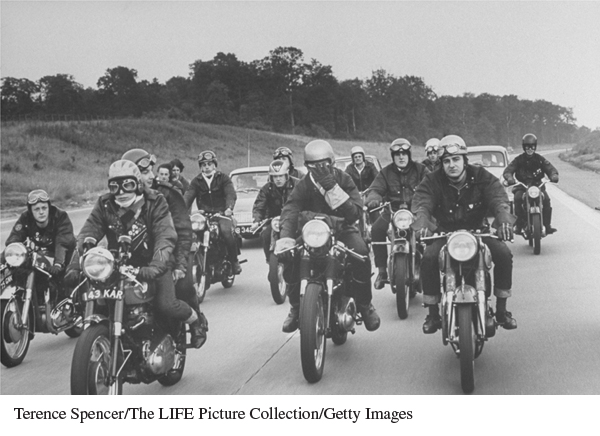A History of Western Society: Printed Page 975
A History of Western Society, Value Edition: Printed Page 93
A History of Western Society, Concise Edition: Printed Page 979
Youth Culture and the Generation Gap
The bulging cohort of so-
Youth styles in the United States often provided inspiration for movements in Europe. Groups like the British Teddy boys, the West German Halbstarken (half-

Youths played a key role in the consumer revolution. Marketing experts and manufacturers quickly recognized that the young people they now called “teenagers” had money to spend due to postwar prosperity. An array of advertisements and products consciously targeted the youth market. In France, for example, magazine advertising aimed at adolescents grew by 400 percent between 1959 and 1962. As the baby boomers entered their late teens, they eagerly purchased trendy clothing and the latest pop music hits, as well as record players, transistor radios, magazines, hair products, and makeup, all marketed for the “young generation.”
The new youth culture became an inescapable part of Western society. One clear sign of this new presence was the rapid growth in the number of universities and college students. Before the 1960s, in North America and Europe, only a small elite received a university education. In 1950 only 3 to 4 percent of western European youths went on to higher education; numbers in the United States were only slightly higher. Then, as government subsidies made education more affordable to ordinary people, enrollments skyrocketed. By 1960 at least three times more European students attended some kind of university than they had before World War II, and the number continued to rise sharply until the 1970s.
The rapid expansion of higher education opened new opportunities for the middle and lower classes, but it also made for overcrowded classrooms. Many students felt that they were not getting the kind of education they needed for jobs in the modern world. At the same time, some reflective students feared that universities were doing nothing but turning out docile technocrats both to stock and to serve “the establishment.” Thus it was no coincidence that students became leaders in a counterculture that attacked the ideals of the affluent society of the postwar world and shocked the West in the late 1960s.